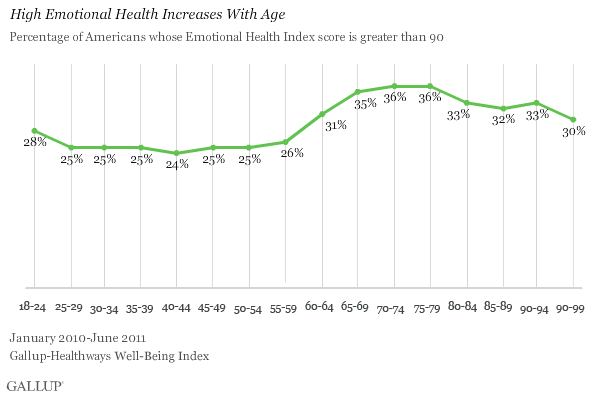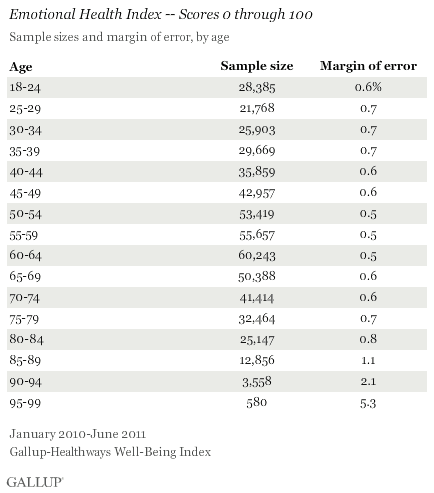This is the first in a series of in-depth articles on emotional health and aging in America. Part one looks at the effect of growing older on one's emotional health. Part two will look at the effects of other demographic traits such as gender, race, and marital status on older Americans' emotional well-being. Other articles will reveal what key factors predict high emotional health among those aged 65 years and older.
WASHINGTON, D.C. -- Americans aged 60 and older demonstrate significantly better emotional health than those younger than 60 years. In fact, a septuagenarian is far more likely than someone in their 30s to have high emotional health. These results hold true even after statistically controlling for gender, race, education, marital status, employment, satisfaction with standard of living, and regional location.

This analysis, based on more than 500,000 interviews conducted between January 2010 and June 2011 as part of the Gallup-Healthways Well-Being Index, measures Americans' Emotional Health Index (EHI) scores, based on self-reports of positive and negative daily emotions as well as clinical diagnosis of depression. Specifically, Americans are asked whether they felt "a lot of" each of the following emotions the day before the survey: smiling/laughing, learning/doing something interesting, being treated with respect, enjoyment, happiness, worry, sadness, anger, and stress. Emotionally well-off Americans are defined as those whose EHI scores are over 90, out of a maximum of 100. Rather than focusing on just happiness or enjoyment, this large set of questions, including respondents' medical diagnoses of depression, provides a more comprehensive view of emotional health.
Across all age groups, an average 28% of Americans are classified as emotionally well off. Less than one in three Americans between the ages of 18 and 24 has high emotional health. Emotional health is slightly lower, and highly stable, among Americans in their mid-20s through their 50s. Starting with Americans in their early 60s, the percentage of those with good emotional health jumps to 31% and is at least 30% among every succeeding age group through age 99.
It should also be noted that Gallup's telephone interview samples may not reach older Americans who are physically impaired or residents of nursing homes and who may have lower emotional health; however the difference is probably not enough to account for the gap in emotional health between those above and below age 60.
Bottom Line
The relationship between emotional health and age tells a tale of two populations: the young and the restless on one hand; the old and the content on the other. In other words, older Americans report much better emotional health, even after holding other demographic variables constant. While many other factors can influence emotional health, these results suggest that, in spite of the tendency to dread aging in the U.S., senior status may be a time to look forward to.
About the Gallup-Healthways Well-Being Index
The Gallup-Healthways Well-Being Index tracks U.S. and U.K. well-being and provides best-in-class solutions for a healthier world. To learn more, please visit well-beingindex.com.

Frank Newport contributed to this article.
Survey Methods
Results are based on telephone interviews conducted as part of Gallup-Healthways Well-Being Index survey Jan. 2, 2010, through June 30, 2011, with a random sample of 520,267 working adults, aged 18 and older, living in all 50 U.S. states and the District of Columbia.
For results based on the total sample of national adults, one can say with 95% confidence that the maximum margin of sampling error is ±1 percentage point.
Margins of error for subgroups have a maximum margin of sampling error of ±3 percentage points.
Interviews are conducted with respondents on landline telephones and cellular phones, with interviews conducted in Spanish for respondents who are primarily Spanish-speaking. Each sample includes a minimum quota of 400 cell phone respondents and 600 landline respondents per 1,000 national adults, with additional minimum quotas among landline respondents for gender within region. Landline telephone numbers are chosen at random among listed telephone numbers. Cell phones numbers are selected using random digit dial methods. Landline respondents are chosen at random within each household on the basis of which member had the most recent birthday.
Samples are weighted by gender, age, race, Hispanic ethnicity, education, region, adults in the household, and phone status (cell phone-only/landline only/both, cell phone mostly, and having an unlisted landline number). Demographic weighting targets are based on the March 2010 Current Population Survey figures for the aged 18 and older non-institutionalized population living in U.S. telephone households. All reported margins of sampling error include the computed design effects for weighting and sample design.
In addition to sampling error, question wording and practical difficulties in conducting surveys can introduce error or bias into the findings of public opinion polls.
For more details on Gallup's polling methodology, visit https://www.gallup.com/.
